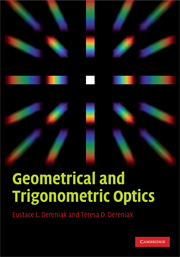Book contents
- Frontmatter
- Contents
- Preface
- 1 Light propagation
- 2 Reflections and refractions at optical surfaces
- 3 Image formation
- 4 Mirrors and prisms
- 5 Curved optical surfaces
- 6 Thin lenses
- 7 Thick lenses
- 8 Mirrors
- 9 Optical apertures
- 10 Paraxial ray tracing
- 11 Aberrations in optical systems
- 12 Real ray tracing
- Appendix A Linear prism dispersion design
- Appendix B Linear mixing model
- Appendix C Nature's optical phenomena
- Appendix D Nomenclature for equations
- Appendix E Fundamental physical constants and trigonometric identities
- Glossary
- Index
Preface
Published online by Cambridge University Press: 06 July 2010
- Frontmatter
- Contents
- Preface
- 1 Light propagation
- 2 Reflections and refractions at optical surfaces
- 3 Image formation
- 4 Mirrors and prisms
- 5 Curved optical surfaces
- 6 Thin lenses
- 7 Thick lenses
- 8 Mirrors
- 9 Optical apertures
- 10 Paraxial ray tracing
- 11 Aberrations in optical systems
- 12 Real ray tracing
- Appendix A Linear prism dispersion design
- Appendix B Linear mixing model
- Appendix C Nature's optical phenomena
- Appendix D Nomenclature for equations
- Appendix E Fundamental physical constants and trigonometric identities
- Glossary
- Index
Summary
This book is an introduction to geometrical optics and is intended for use in courses on optical engineering. Although several excellent books already exist that cover both physical and geometrical optics, it has been our experience that the purpose of these books is not to teach the fundamentals of geometrical optics, but rather to introduce the subject in order to prepare students for more challenging physical optics courses to follow. In contrast, this book will teach the subject in such a way that it will provide future optical engineers with a solid background and the skills necessary to understand modern computer optical design programs used by lens designers. Furthermore, unlike previous textbooks, this book uses a right-handed coordinate system that lends itself more efficiently to lens design techniques, such as integrating multiple lenses in cascade.
This book is geared toward the professional engineer or student who wants to gain a broad understanding of geometrical optics with the details worked out. It uses a student's prior background in basic high school level algebra, trigonometry, and calculus to build a foundation for the concept of image formation, using linear equations to describe where the image is formed, its size and its classical third-order aberrations, and to teach all fundamental topics necessary to understand complex optics used in optical instruments.
The book has grown out of class notes developed for an introductory course in geometrical optics offered as part of the optical engineering curriculum at the University of Arizona College of Optical Sciences, Tucson, Arizona.
- Type
- Chapter
- Information
- Geometrical and Trigonometric Optics , pp. ix - xPublisher: Cambridge University PressPrint publication year: 2008



